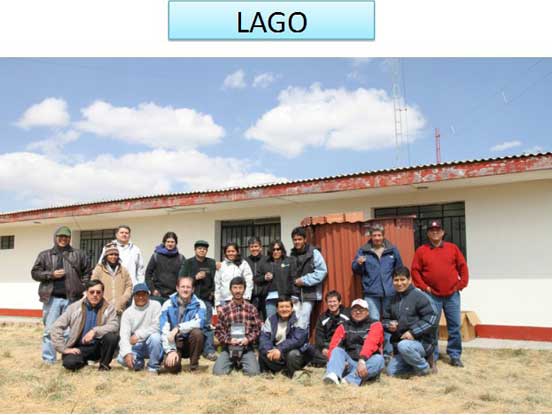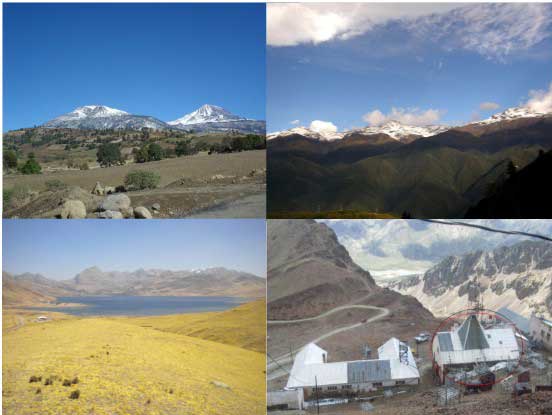The Large Aperture Gamma Ray Observatory (LAGO)
Luis Villaseñor
Gamma-ray bursts (GRBs) are the most powerful explosions in the Universe. They were serendipitously discovered in 1967 by the Vela (from the Spanish verb velar, which means "to watch") satellites launched by the US government to monitor covert nuclear tests from space. The Vela program studied GRBs further and they declassified and published their discovery in 1973. Ever since, GRBs have been the focus of intense observational and theoretical research from the astrophysical community.
An important breakthrough in their understanding occurred in May 1997, when the spectrum of the optical afterglow of a GRB, detected by the BeppoSAX satellite a few hours earlier in a faint and distant galaxy, was analyzed; the redshift measured for that particular galaxy placed it at an approximate distance of 6 billion light years from Earth. This ends a long controversy about the origin of GRBs and making clear that they are extragalactic events originating within faint galaxies at enormous distances.
GRBs are characterized by the sudden emission of gamma rays during very short time intervals (between 0.1 and 100 seconds). The integrated luminosities are typically between 1051 and 1055 ergs, i.e., much greater than the integrated luminosity of a typical star, like our Sun, during its whole lifetime. The astrophysical sources of these bursts are still unclear but good candidates are coalescence of compact objects (neutron stars) for short bursts (less than 2 s), and supernovae produced by very massive stars (hypernovae) for the long bursts (more than 2 s).
Although past (BATSE/CGRO, BeppoSAX) and present satellite observations (SWIFT, FERMI) have revealed some mysteries about the origin and location of GRBs, some important questions remain associated with higher energies (>1 GeV), such as their energy spectrum or the existence of a cut-off energy. Up to now no ground-based experiment has detected the gamma rays from GRBs.
The Large Aperture Gamma Ray Observatory, or LAGO, is a multi-site facility designed to observe the high-energy component of GRBs. This international collaboration, formed by approximately 75 people from 25 scientific institutes representing 12 countries, has constructed, starting in 2006, a network of ground-based water Cherenkov detectors (WCDs). Located at mountain altitudes, above 4500 m.a.s.l., to study high-energy GRBs, where the flux of the primary gamma rays is too low for effective detection by small-area satellite-borne detectors, LAGO has been taking data since 2007.
When high-energy photons from a GRB reach the atmosphere, they produce cosmic-ray cascades that can be detectable at ground level by using WCDs. These detectors are placed at mountain altitudes to increase their sensibility to primary gamma rays. Rather than trying to detect the extensive air showers produced by the primary gamma rays, LAGO makes use of the so-called single-particle technique to indirectly detect the bursts of high-energy gamma rays by trying to observe excess in the counting rates of secondary cosmic rays during the duration of the bursts. The main advantage of water Cherenkov detectors with respect to other detectors used for this purpose in previous experiments, such as plastic scintillators, is their higher sensitivity to photons, which represent up to 90% of the secondary particles at ground level for high-energy primary photons.
At present the LAGO Observatory consists of three sites in operation:- Sierra Negra in Mexico at 4550 m.a.s.l. This was the first LAGO site, in operation since 2007. Three 4 m2 and two 1 m2 WCD have been in operation at the site. Currently, new water Cherenkov detectors of 40 m2 are under construction.
- Chacaltaya in Bolivia at 5250 m.a.s.l. This is the highest site of LAGO and the one with the best infrastructure. Three WCD are in, two of 4 m2 and one of 1 m2. They have been taking data since 2008.
- Marcapomacocha in Peru at 4450 m.a.s.l. This is the most recent LAGO site, with one 2 m2 WCD taking data since 2010.
- Centro Atomico Bariloche in Argentina, a prototype is used for calibration and software tests since 2006.
- WCD prototypes are taking data at several universities (Caracas and Merida in Venezuela, Bucaramanga in Colombia, Lima and Cuzco in Peru, Morelia and Puebla in Mexico and Guatemala City in Guatemala)
- Pico Espejo, in Merida, Venezuela, where three 4 m2 WCDs have been installed at 4750 m.a.s.l. Unfortunately, the Merida cable car had a failure and was shut down in 2008.
New sites, in Guatemala, Chile and Brazil, are expected to join LAGO in the near future. All the LAGO sites were selected on the basis of their high altitude, simultaneous view of parts of the sky, good infrastructure and easy access. A prerequisite has been the existence of nearby groups of physicists interested in the construction and operation of their respective site.
The WCDs in all the sites share similar characteristics: They are filled with high quality purified water up to a level of 1.2 to 1.5 m, ensuring a full efficiency for photon detection through pair production in the water volume. The water is contained in a reflective and diffusive bag to achieve optimal uniformity of the detector response. A single photomultiplier tube, usually 8” in diameter overlooks the water volume. The signal is digitized and read out by custom-made electronics and software.
Although no GRBs have been observed by LAGO to date, their data have been used to set limits on the integrated energy flux of GRBs detected by satellites, with the most stringent one being 1.6x10−6erg cm −2 for GRB 080904 in the 0.5 GeV - 100 GeV energy range. LAGO data are also used to monitor solar activity through the modulation effect that solar activity has on galactic cosmic rays, giving rise to Forbush decreases. A monitoring program has started to provide an observation network of solar activity, complementary to the existing network of neutron detectors.

Members of the LAGO collaboration in the Marpacomapocho site in Peru.

LAGO sites: Sierra Negra in Mexico (upper left), Pico Espejo in Venezuela (upper right), Marcapomacocha in Peru (lower left) and Chacaltaya in Bolivia (lower right).
Luis Manuel Villasenor-Cendejas is the Scientific Research Coordinator at Universidad Michoacana de San Nicolas de Hidalgo and also a member of the Institute of Physics and Mathematics at the same university in Morelia, Mexico.
Disclaimer—The articles and opinion pieces found in this issue of the APS Forum on International Physics Newsletter are not peer refereed and represent solely the views of the authors and not necessarily the views of the APS.
